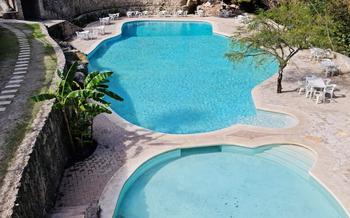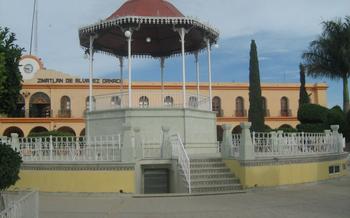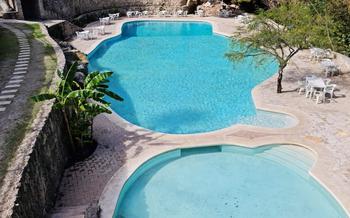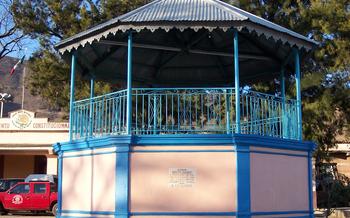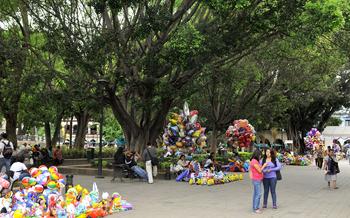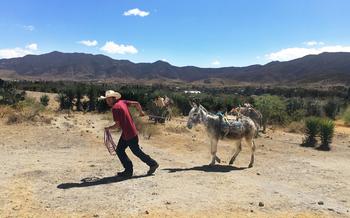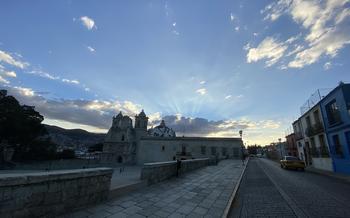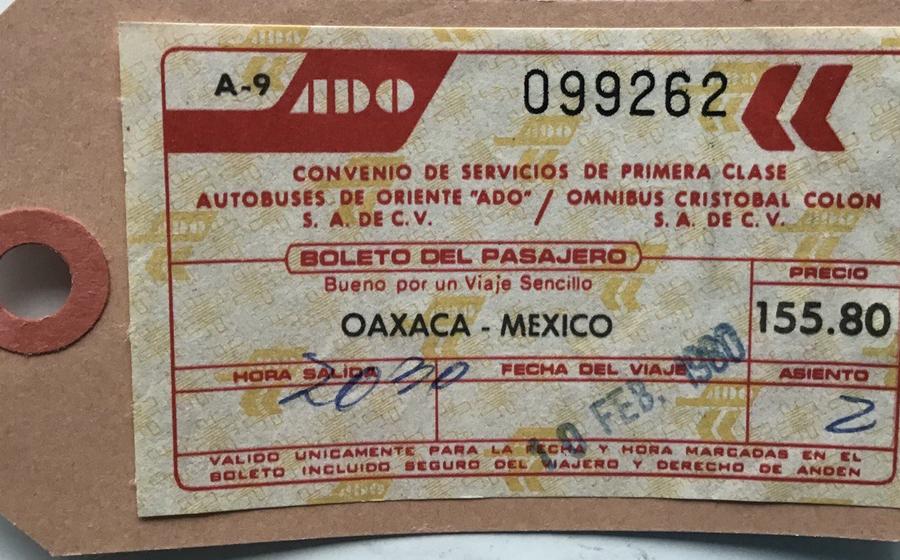
San Martín Tilcajete (Alebrijes Village)
- San Martín Tilcajete, the Village of Alebrijes
- Visiting San Martín Tilcajete
- Exploring the Village
- Meeting the Artisans
- Witnessing the Creative Process
- Choosing Your Perfect Alebrije
- Supporting the Local Economy
- Photography Opportunities
- Authentic Experiences
- Unique Souvenirs
- Cultural Significance
- Sustainability
- Accessibility
- Off-the-Beaten-Path Destination
- Insider Tip: Unforgettable Experiences in San Martín Tilcajete
San Martín Tilcajete, the Village of Alebrijes
In the heart of Mexico's colorful Oaxaca state, nestled amidst the breathtaking Sierra Madre Mountains, lies the enchanting village of San Martín Tilcajete, renowned worldwide as the Village of Alebrijes. This magical place is where the ancient art of alebrije making thrives, captivating visitors with its vibrant colors, intricate carvings, and fantastical creatures.
The history of San Martín Tilcajete is deeply intertwined with the alebrije, a whimsical and often bizarre wooden figurine that has become an iconic symbol of Mexican folk art. The term "alebrije" is said to have originated from a dream experienced by Pedro Linares López, a local artisan, in the 1930s. In his dream, Linares encountered fantastical creatures with vibrant colors and intricate patterns, which he later recreated in his wood carvings, giving birth to the unique style of San Martín Tilcajete's alebrijes.
Over the years, the village's reputation for its alebrijes grew, attracting visitors from around the world. Today, San Martín Tilcajete is a thriving center for alebrije making, with numerous workshops and galleries showcasing the incredible craftsmanship of its talented artisans.
Visiting San Martín Tilcajete
Getting to San Martín Tilcajete is relatively easy. From Oaxaca City, you can take a direct bus or colectivo (shared van) from the Central de Abastos market. The journey takes about an hour and costs around $50 pesos. Once you arrive in the village, you can easily explore on foot.
For accommodation, there are a few small hotels and guesthouses in San Martín Tilcajete, but it's also possible to stay in nearby Oaxaca City and make a day trip to the village. There are also several restaurants in the village where you can enjoy traditional Oaxacan cuisine.
The best time to visit San Martín Tilcajete is during the dry season, which runs from November to April. During this time, the weather is pleasant and there are fewer crowds. However, the village is also worth visiting during the rainy season (May to October) when the surrounding mountains are lush and green.
Exploring the Village
Strolling through the main square of San Martín Tilcajete, you'll be greeted by the imposing sight of the church, its colonial architecture a testament to the village's rich history. The narrow streets that branch out from the square are lined with colorful houses, each adorned with intricate paintings and vibrant murals. These streets are a living canvas, showcasing the artistic talents of the local residents.
As you wander through the village, you'll notice the ubiquitous presence of alebrijes, peeking out from doorways, perched on rooftops, and displayed in front of workshops. These fantastical creatures, with their vibrant colors and intricate designs, seem to come alive in the sunlight, adding a touch of magic to the everyday life of the village.
One of the highlights of exploring San Martín Tilcajete is visiting the workshops and galleries where the alebrijes are created. Here, you'll have the opportunity to witness the artisans at work, transforming simple pieces of wood into extraordinary works of art. The workshops are often open to visitors, allowing you to peek into the creative process and learn about the traditional techniques used to create these unique pieces.
Meeting the Artisans
The heart of San Martín Tilcajete beats within the families of artisans who have dedicated their lives to the craft of alebrije making. These families, steeped in tradition, possess a wealth of knowledge and skills that have been passed down through generations.
Each family has its own unique style and approach to creating alebrijes, but they all share a deep passion for their work. They take pride in every piece they create, imbuing it with their own creativity and personality.
The artisans of San Martín Tilcajete are masters of their craft, using traditional techniques that have remained largely unchanged for centuries. They begin by selecting the perfect piece of wood, often copal or cedar, and then painstakingly carve it into the desired shape. The carving process can take several days or even weeks, depending on the complexity of the design.
Once the carving is complete, the artisans sand the wood to a smooth finish and then begin the painting process. They use vibrant acrylic paints to create intricate designs and patterns, often inspired by nature or their own imagination. The painting process can be just as time-consuming as the carving, and some alebrijes may require multiple layers of paint to achieve the desired effect.
The artisans of San Martín Tilcajete are not only skilled craftsmen but also storytellers. Their alebrijes often depict scenes from Mexican mythology or everyday life, and each piece carries a unique meaning or message. By purchasing an alebrije, you are not only acquiring a beautiful work of art but also supporting the livelihood of these talented artisans and preserving a cherished cultural tradition.
Witnessing the Creative Process
Step into the heart of the creative process as you observe the artisans of San Martín Tilcajete transform ordinary wood into extraordinary works of art. With nimble hands and a keen eye for detail, they meticulously carve and shape the wood, giving life to the whimsical forms that characterize their alebrijes.
Each artisan has a unique style and technique, but the process generally follows a similar pattern. First, they select a suitable piece of wood, often copal or cedar, and roughly carve the basic shape of the alebrije. They then use chisels and gouges to refine the details, creating intricate patterns and textures on the surface.
Once the carving is complete, the alebrije is ready to be painted. The artisans use a vibrant palette of acrylic paints to bring the creatures to life, creating bold and eye-catching designs that often incorporate traditional Mexican motifs and symbols. The final touch is a layer of varnish to protect the paint and enhance the colors.
Watching the artisans work is a mesmerizing experience that offers a glimpse into their skill, dedication, and passion for their craft. Each alebrije is a unique masterpiece, and you'll leave San Martín Tilcajete with a newfound appreciation for the artistry and craftsmanship that goes into creating these incredible works of art.
Choosing Your Perfect Alebrije
When selecting an alebrije in San Martín Tilcajete, you'll be spoilt for choice. The variety of sizes, shapes, and designs is astounding, reflecting the creativity and imagination of the artisans.
For a truly unique piece, consider requesting a custom-made alebrije. The artisans are skilled at bringing your ideas to life, creating a one-of-a-kind masterpiece that you'll cherish forever.
To ensure you're getting a high-quality alebrije, look for intricate details, smooth finishes, and vibrant colors. The weight and balance of the piece should also be considered, especially if you intend to display it prominently.
The prices of alebrijes vary depending on their size, complexity, and the reputation of the artisan. Bargaining is acceptable, but it's important to be respectful and fair. Remember that the artisans rely on their craft for their livelihood.
When negotiating a price, it's helpful to have a general idea of the value of the alebrije. You can do this by comparing prices at different workshops or by asking your guide or hotel staff for advice.
By purchasing an alebrije directly from the artisan, you not only take home a beautiful piece of art but also support the local economy and preserve this important cultural tradition.
Supporting the Local Economy
San Martín Tilcajete's economy revolves around the sale of alebrijes. By purchasing directly from the artisans, you are directly supporting their livelihoods and the preservation of their traditional craft. The artisans set their own prices, ensuring that they receive fair compensation for their work.
Fair trade practices are highly valued in San Martín Tilcajete, with many artisans adhering to cooperatives and collectives that promote equitable distribution of profits and resources. Buying from these cooperatives ensures that the benefits of tourism are shared throughout the community.
Tourism plays a crucial role in sustaining the village's economy. The income generated from alebrije sales helps support local businesses, such as restaurants, hotels, and shops. This, in turn, creates jobs and opportunities for other members of the community.
By choosing to visit San Martín Tilcajete and purchase an alebrije, you are not only taking home a unique piece of Mexican folk art but also contributing to the preservation of a centuries-old tradition and supporting the local economy.
Photography Opportunities
San Martín Tilcajete is a visual feast for photography enthusiasts. The vibrant colors and intricate details of the alebrijes make them irresistible subjects to capture. Photographing the artisans at work, with their skilled hands carving and painting these fantastical creatures, offers a glimpse into the creative process. Stepping back and taking panoramic shots of the village, with its colorful houses and lush surroundings, provides a sense of the unique atmosphere that permeates this special place. Don't forget to capture the smiles and interactions of the friendly locals, who are always happy to share their stories and traditions with visitors.
Authentic Experiences
Beyond shopping for alebrijes, there are several ways to immerse yourself in the culture and traditions of San Martín Tilcajete. One unforgettable experience is participating in a traditional alebrije-making workshop. Under the guidance of skilled artisans, you'll learn the techniques of carving, shaping, and painting your own alebrije. It's a hands-on opportunity to create a unique souvenir while gaining a deeper appreciation for the craftsmanship involved.
Savor the flavors of Oaxacan cuisine by indulging in a traditional meal in the village. Sample local specialties like tlayudas (large, crispy tortillas topped with beans, cheese, and various ingredients), tamales, and mole, a rich and complex sauce made with chiles, spices, and chocolate. The village's restaurants and mercados offer a delightful culinary journey that complements the visual feast of the alebrijes.
For an immersive cultural experience, plan your visit to coincide with the Day of the Dead celebrations, held annually from October 31 to November The village transforms into a vibrant spectacle, with colorful altars adorned with marigolds, candles, and offerings to honor deceased loved ones. Witness traditional dances, music, and processions that showcase the unique blend of indigenous and Spanish traditions that define Oaxaca's rich cultural heritage.
Unique Souvenirs
San Martín Tilcajete is a treasure trove of unique and handmade souvenirs. Alebrijes of all sizes, shapes, and designs are available for purchase, making it the perfect place to find a one-of-a-kind gift for yourself or a loved one. From tiny, intricate pieces to large, eye-catching sculptures, there's something to suit every budget and taste.
In addition to alebrijes, San Martín Tilcajete is also known for its other traditional crafts. Woven baskets, colorful textiles, and intricately carved wooden masks are just a few of the items you'll find in the village's shops and galleries. Be sure to take your time browsing and selecting your souvenirs, as each piece is unique and handmade with love.
When packing your souvenirs, be sure to wrap them carefully to avoid damage during transport. Consider purchasing a sturdy carrying case or suitcase to protect your delicate purchases. You may also want to consider shipping your souvenirs home if you're traveling with a lot of luggage.
Cultural Significance
Alebrijes hold a significant place in Mexican culture, representing a unique blend of art, mythology, and tradition. These fantastical creatures are deeply rooted in the indigenous Zapotec culture of Oaxaca, where they are believed to represent the spirit animals that guide and protect individuals. Alebrijes often depict mythical creatures with vibrant colors and intricate patterns, each one embodying a unique story or legend.
Beyond their spiritual significance, alebrijes serve as a form of artistic expression for the people of San Martín Tilcajete. The artisans pour their creativity and imagination into each piece, resulting in a diverse range of designs that reflect their personal experiences, beliefs, and connection to the natural world.
The creation and appreciation of alebrijes have become an integral part of the cultural identity of San Martín Tilcajete. These fantastical figures not only bring joy and wonder to those who behold them but also serve as a testament to the rich cultural heritage of Mexico.
Sustainability
San Martín Tilcajete is known for its commitment to preserving its traditions and protecting the environment. Many artisans use sustainable materials in their work, such as recycled wood and natural dyes. The village is also working to reduce its carbon footprint by promoting eco-friendly tourism practices. Visitors are encouraged to walk or bike around the village, and there are several eco-friendly hotels and restaurants available. By embracing sustainability, San Martín Tilcajete is ensuring that its unique traditions will continue to thrive for generations to come.
Accessibility
San Martín Tilcajete's proximity to Oaxaca City, just a 30-minute drive away, makes it an easily accessible destination. Guided tours and transportation options are readily available, ensuring a hassle-free journey for visitors. The village is well-prepared to accommodate visitors with disabilities, offering wheelchair-accessible paths, ramps, and designated parking areas. Visitors can navigate the village's cobblestone streets and workshops with ease, ensuring that everyone has the opportunity to experience the magic of San Martín Tilcajete.
Off-the-Beaten-Path Destination
San Martín Tilcajete is a hidden gem, an off-the-beaten-path destination that offers a unique and authentic experience. Unlike other popular tourist spots in Mexico, this village has managed to preserve its traditional way of life and its rich cultural heritage. Visitors to San Martín Tilcajete will be immersed in a vibrant and colorful world, where they can witness the creation of intricate alebrijes and interact with the talented artisans who bring these fantastical creatures to life.
Strolling through the narrow streets of the village, visitors will be captivated by the colorful houses and the numerous workshops where artisans create their masterpieces. The absence of large crowds allows for a more intimate and personal experience, where travelers can engage with the locals and learn about their traditions and customs. San Martín Tilcajete is a place where time seems to stand still, offering a glimpse into the heart and soul of rural Mexico.
Insider Tip: Unforgettable Experiences in San Martín Tilcajete
For an unforgettable experience in San Martín Tilcajete, immerse yourself in the vibrant Alebrije Festival, an annual celebration that showcases the finest alebrijes crafted by local artisans. Witness the streets adorned with colorful creations and participate in lively festivities, including traditional music, dance performances, and art exhibitions.
Additionally, don't miss the opportunity to attend a traditional Guelaguetza performance, a cultural extravaganza that brings together indigenous communities from across Oaxaca to showcase their unique traditions, music, and dance. This breathtaking spectacle offers a glimpse into the rich cultural heritage of the region.
To fully appreciate the artistry of the region, venture beyond the village and explore the surrounding towns and attractions. Discover hidden gems like the ancient ruins of Monte Albán, marvel at the natural beauty of the Hierve el Agua petrified waterfalls, and immerse yourself in the vibrant markets and colonial architecture of nearby villages.

